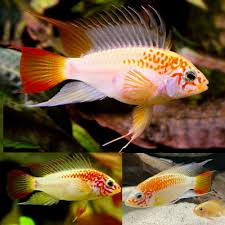1
/
of
1
Midwest Aquarium and Pond Supplier LLC
(134)Apistogramma Viejita Red 1in
(134)Apistogramma Viejita Red 1in
Regular price
$30.00 USD
Regular price
Sale price
$30.00 USD
Shipping calculated at checkout.
Quantity
Couldn't load pickup availability
The term "Apistogramma Viejita Red" most likely refers to the Red Neck Apisto (Apistogramma viejita "Red"). However, it is important to note that many dwarf cichlids are mislabeled, and the fish you purchase might actually be a red variant of another common Apistogramma species, such as A. macmasteri. Regardless, the care requirements for these similar dwarf cichlids are broadly the same.
Tank setup
- Tank size: A 20-gallon or larger tank is ideal for a pair or small group (one male, several females). For a community tank, a 30-gallon or larger is recommended.
- Substrate: A soft, fine sand substrate is crucial. These cichlids are "micro-eartheaters" and love sifting through the sand for food.
- Decorations: Provide plenty of hiding spots and visual barriers using driftwood, small caves (like clay pots or coconut shells), and dense live plants. This helps establish territories and reduces aggression. Floating plants can also help diffuse bright lighting, which they prefer.
- Filtration: A gentle filter is essential to provide the calm water conditions they prefer.
Water parameters
- Temperature: Maintain a stable temperature between 72–86°F (22–30°C).
- pH: A slightly acidic to neutral pH of 6.0–7.5 is ideal for most captive-bred Apistogramma, but stability is more important than an exact number.
- Water changes: Perform regular, small-to-moderate water changes to keep nitrate levels low and prevent sudden shifts in water parameters, which these fish can be sensitive to.
Diet and feeding
- Carnivorous diet: Apistogramma are micropredators in the wild, so their diet should be high in protein.
-
Food types:
- Staple: High-quality pellets or flakes designed for carnivores.
- Supplements: Include frozen or live foods, such as baby brine shrimp, daphnia, or bloodworms.
- Feeding schedule: Feed small amounts two to three times per day to encourage natural foraging behavior.
Temperament and tank mates
- Temperament: While generally peaceful, males can become territorial, especially during spawning. Keeping a single male with multiple females (a harem) can help spread out aggression. Females are also very protective of their eggs and fry.
-
Tank mates: Choose peaceful, non-aggressive species. Good tank mates include:
- Small tetras (e.g., Neons, Embers, Rummy Nose)
- Corydoras catfish
- Rasboras
- Incompatible companions: Avoid larger, aggressive fish that might bully them. Also, avoid housing them with dwarf shrimp or other small, delicate invertebrates, as they may become food.
Breeding
- Cave spawners: Apistogramma viejita are cave-spawning fish, with the female guarding the eggs inside a cave.
- Triggering spawn: To encourage breeding, provide plenty of caves and maintain soft, slightly acidic water. A high-protein diet also helps.
- Parental care: The female will care for the eggs and fry, while the male defends the outer territory.
Share
No reviews

